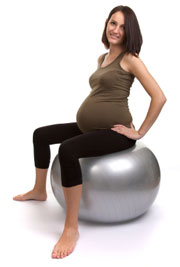- Introduction
- Exercise and pregnancy-related risk
- Exercise outcomes on birth weight and foetal growth
- Obesity and pregnancy
- Psychological benefits of exercise during pregnancy
- Physiological benefits of exercise during pregnancy
- Risks of exercise during pregnancy
- Contraindications for exercise during pregnancy
Introduction
Many women are hesitant to engage in any sort of physical activity while they are pregnant, and rightfully so. Exercise has been believed to increase risks associated with pregnancy but many of these beliefs have not been proven with scientific evidence. It has only been in the last ten years that this area has been thoroughly researched and it has been found that not only is exercise during pregnancy safe but it is beneficial for both the mother and for her baby.
This is not to say that there are no risks at all. All women who exercise while pregnant should seek advice from their doctor to ensure they are not over doing it or engaging in specific activities that should be avoided.
More information on Exercises to Do and Avoid during Pregnancy.
Exercise and pregnancy-related risk
Gestational diabetes mellitus (GDM)

More information on Exercise before Pregnancy.
The risk of preeclampsia is significantly reduced in women who exercise during pregnancy compared to inactive women. This effect is strengthened in women who are physically active before as well as during their pregnancy.
There tends to be a lower rate of caesarean delivery among exercising women.
Exercise outcomes on birth weight and foetal growth
 |
|
Image courtesy of Blausen Medical Communications. Contact Andrew Walbank. |
There is evidence that maternal exercise may reduce birth weight of the infant but studies suggest that this effect is minor and not associated with adverse outcomes for the infant. Exercise in pregnancy is associated with a decrease in offspring that are significantly small for gestational age (SGA). SGA means that for the time spent in gestation (the gestational age) the infant is in the smallest 10% for all infants born at that age and that sex. So while there may be trends that indicate that exercising during pregnancy decreases the birth weight of offspring, this is not significant or harmful as exercise reduces the risk of an offspring being significantly small.
It is important to recognise that birth weight is not the only indicator of impaired foetal growth. There are other indicators that can be measured to fully assess whether the infant has grown optimally during pregnancy. Small abdominal circumference is directly correlated to a small liver and can also be related to high cholesterol levels in later life. Small head circumference is directly correlated with small brain size and accordingly an impaired IQ. Small head circumference can also indicate that the baby will grow to exhibit high blood pressure, an increased risk of heart disease and impaired glucose tolerance. No negative effect of exercise on these measures of foetal growth has been identified but further research into this area is necessary.
The birth weight of the child is affected less by exercising during pregnancy than the mother’s body mass index (BMI). Overweight and obese women are more likely to have babies with a large infant birth weight. Women who exercise are less likely to have larger babies. Therefore exercise in pregnancy may elicit a “protective” effect against offspring that are identified as large for gestational age (LGA). LGA means that for the time spent in gestation the infant is in the largest 90% for all infants born at that age and sex.
Obesity and pregnancy

More information on Health Risks of Overnutrition in Pregnancy.
Exercise can be used to combat excessive weight gain with the help of your doctor who may prescribe a safe exercise regime to adopt during pregnancy. In order to reduce excessive weight gain your doctor will suggest aerobic exercises that utilise a large number of muscle groups, if this is believed to be safe for you and your baby. Aerobic exercises that do not pose any risks during low risk pregnancies include walking, stationary cycling, aquatic exercise or low impact aerobics around 3 to 4 times a week.
More information on How Much Weight to Gain during Pregnancy.
Psychological benefits of exercise during pregnancy
Studies have identified that women who keep fit during pregnancy are more relaxed and therefore cope better with the emotional and physiological strains of pregnancy, including the demands of labour. Women who exercise have a better sense of wellbeing due to a number of positive effects from exercise such as greater weight control, better body image and self-esteem, improved sleep and increased energy levels. It is believed that this positive effect on mental health continues after pregnancy and may decrease the incidence of postnatal depression.
Physiological benefits of exercise during pregnancy

- Increased cardiovascular and muscular fitness and strength;
- Improved posture due to increased abdominal and upper body strength;
- Improved circulation which reduces the incidence of varicose veins and deep vein thrombosis;
- Reduced constipation, bloating and swelling;
- Lower incidence of back pain;
- A greater chance of experiencing easier deliveries with less medical interventions; and
- Healthier babies.
The benefits are also maintained after birth with some women reporting improved sporting performance in the months immediately following birth. This is thought to be related to the increased respiratory volume, cardiac output and blood volume that occur during pregnancy which is accompanied by improved oxygen capacity.
Risks of exercise during pregnancy
While exercise has been established as a safe practice for women who are pregnant, there are risks that can make it dangerous for some women with particular medical conditions.
Firstly, the hormones stimulated during pregnancy have the potential to induce premature contractions, although the actual risk of this event has not been investigated. Exercise also causes blood to be redistributed from internal organs to skeletal muscle and as a result there is a significant reduction in oxygen and nutrient delivery to the placenta.
Potential mechanisms behind why exercise during pregnancy can be a risk have been identified, yet there have been no studies that have shown these have a significant effect on foetal wellbeing. The major concerns include:
- Premature contractions can potentially be induced by the hormones that are stimulated by exercise;
- Increased glucose consumption from working muscles could affect foetal glucose levels;
- Exercise causes blood to be redistributed from internal organs to skeletal muscle and as a result there is a significant transient reduction in oxygen and nutrient delivery to the placental site; and
- Overheating will challenge maternal thermoregulation and is best avoided, especially in the first trimester. Therefore participating in vigorous exercise in high temperature environments throughout pregnancy should be avoided.
More information on Safety Considerations when Exercising during Pregnancy.
Contraindications for exercise during pregnancy

- Heart disease;
- Restrictive lung disease – a lung condition which impairs the function of the lung so that it is restricted in expansion while breathing. This results in reduced lung function as breathing and ventilation is restricted;
- Incompetent cervix – a medical condition in which the cervix begins to dilate before the full term of the pregnancy;
- Premature labour;
- Premature ruptured membranes – after the water breaks;
- Preeclampsia/pregnancy-induced hypertension;
- Persistent second or third trimester bleeding; and
- Placenta praevia – a complication during pregnancy when the umbilical cord is attached to the uterine wall and it is close to or even covering the cervix.
More information
 |
For more information about pregnancy and exercise, including pre-pregnancy exercise, suitable types of exercise, risks and benefits of exercise and exercise myths, see Pregnancy and Exercise. |
 |
For more information about pregnancy, including preconception advice, stages of pregnancy, investigations, complications, living with pregnancy and birth, see Pregnancy. |
 |
For more information on fitness and exercise, including stretches, types of exercise, exercise recovery and exercise with health conditions, as well as some useful videos, see Fitness |
References
- Mottola M. Exercise Prescription for Overweight and Obese Women: Pregnancy and Postpartum. Obstet Gynecol Clin N Am. 2009; 36: 301–16. [Full text]
- Penney DS. The effect of vigorous exercise during pregnancy. J Midwifery Women’s Health. 2008; 53: 155–9. [Abstract]
- National Collaborating Centre for Women’s and Children’s Health. Antenatal care: routine care for the healthy pregnant woman. Clinical Guideline March 2008 2nd ed. RCOG Press; London: 2008. [Full Text]
- American Congress of Obstetricians and Gynecologists: Exercise during pregnancy [online]. ACOG 2003 [cited June 2010]. Available: URL Link
- Davies GAL, Wolfe LA, Mottola MF, MacKinnon C. Exercise in pregnancy and the postpartum period. Joint SOGC/CSEP Clinical Practice Guideline. 2003; 129: 1 – 7. [Full Text]
- Sydney South West Academy of Sport Policy Statement: Exercise During Pregnancy [online]. SWSAS [cited June 2010]. Available from: URL Link
- Gavard JA, Artal R. Effect of exercise on pregnancy outcome. Clin Obs Gynecol. 2008; 51(2): 467–80. [Abstract]
- Fleten C, Stigum H, Magnus P, Nystad W. Exercise During Pregnancy, Maternal Prepregnancy Body Mass Index, and Birth Weight. Clin Obs Gynecol. 2010; 115(2): 331-7. [Abstract]
- Juhl M, Olsen J, Andersen P, Aagaard E, Nybo Andersen A. Physical exercise during pregnancy and fetal growth measures: a study within the Danish National Birth Cohort. Am J Obstet Gynecol. 2010; 202(63): e1-e8. [Abstract]
- NSW Government Communities Sport and Recreation: Exercise during pregnancy [online]. [cited June 2010]. Available from: URL Link
All content and media on the HealthEngine Blog is created and published online for informational purposes only. It is not intended to be a substitute for professional medical advice and should not be relied on as health or personal advice. Always seek the guidance of your doctor or other qualified health professional with any questions you may have regarding your health or a medical condition. Never disregard the advice of a medical professional, or delay in seeking it because of something you have read on this Website. If you think you may have a medical emergency, call your doctor, go to the nearest hospital emergency department, or call the emergency services immediately.








